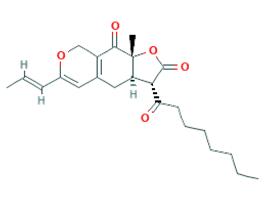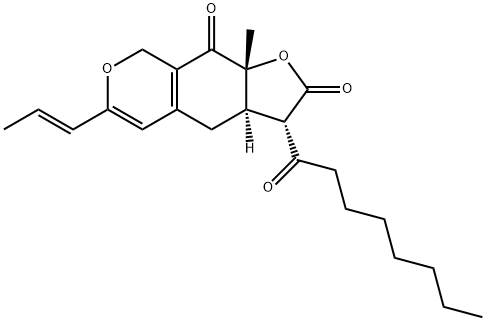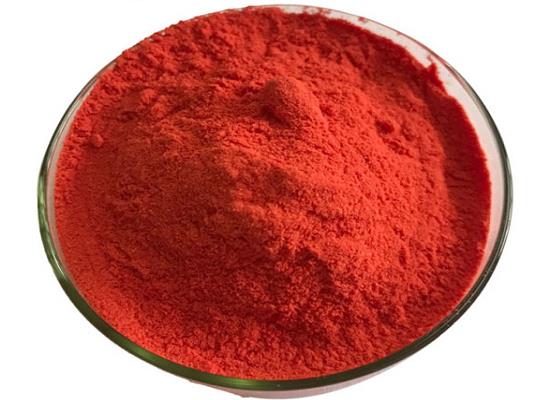Ankaflavin – one of secondary metabolites from Monascus-fermented products
Ankaflavin (AK), isolated from Monascus-Fermented red rice, is a PPARγ agonist with anti-inlfammatory activity. Ankaflavin is an active compound having anti-inflammatory, anti-cancer, antiatherosclerotic, and hypolipidemic effects.

Monascus-fermented red rice has traditionally been used as a natural food colorant or food preservative of meat and fish for centuries. Recently, it has become a popular dietary supplement due to many of its bioactive constituents being discovered. According to the cell-based cytotoxicity assay, a compound with selective cytotoxicity was found and identified as ankaflavin. Ankaflavin was found to be toxic to human cancer cell lines Hep G2 and A549 with a similar IC50 value of 15 μg/mL, while it posed no significant toxicity to normal MRC-5 and WI-38 cells at the same concentration [1].
Ankaflavin exhibits selective cytotoxic effect and induces cell death on cancer cells. Bao-Hong Lee etc. reported that ankaflavin acted as an antioxidant and antidiabetic drug; however, the mechanism by which ankaflavin prevented diabetes remains unknown. Hyperglycemia is associated with protein glycation, which produces advanced glycation end-products (AGEs). Methyl-glyoxal (MG)—a metabolite of carbohydrates—is believed to cause insulin resistance by inducing inflammation and pancreas damage. Diabetes was induced in Wistar rats (4weeksofage) by treating them with MG (600 mg/kg bw) for 4 weeks. They observed that ankaflavin (10 mg/kg bw) exerted peroxisome proliferator-activated receptor-γ (PPARγ) agonist activity, thereby enhancing insulin sensitivity (as indicated by hepatic GLUT2 translocation, PTP1B suppression, and glucose uptake) by down regulating blood glucose and up regulating pancreatic and duodenal homeobox-1 and Maf- A expression and increasing insulin production in MG-induced rats. However, these effects were abolished by the administration of GW9662 (PPARγ antagonist), but the expression of hepatic heme oxygenase-1(HO-1) and glutamate–cysteineligase (GCL) was not suppressed in MG-induced rats. Therefore, the nuclear factorery throid-related factor-2 (Nrf2) activation was investigated. ankaflavin did not affect hepatic Nrf2 mRNA or protein expression but significantly increased Nrf2 phosphorylation (serine 40), which was accompanied by increased transcriptional activation of hepatic HO-1 and GCL. These data indicated that ankaflavin protected rats from oxidative stress resulting from MG-induced insulin resistance. In contrast, these effects were not detected when the rats were treated with the antidiabetic drug rosiglitazone (10 mg/kg bw). Moreover, They found that AK did not inhibit the generation of AGEs in vitro; however, the glutathione (GSH) levels in liver and pancreas of MG-induced rats were elevated in rats administered ankaflavin. Therefore, we believe that GSH may lower the MG level, which attenuates the formation of AGEs in the serum, kidney, liver, and pancreas of MG-induced rats. They also found that ankaflavin treatment reduced the production of inflammatory factors, such as tumor necrosis factor-α and interleukin-1β. Taken together, the results of our mechanistic study of MG-induced rats suggest that the protective effects of AK against diabetes are mediated by the up regulation of the signaling pathway of Nrf2, which enhances antioxidant activity and serves as a PPARγ agonist to enhance insulin sensitivity [2].
Monascus-fermented products have been used as dietary food and traditional medicine due to their beneficial effects on circulation and digestive systems in Asia for thousands of years. Besides, monascin and ankaflavin, secondary metabolites from Monascus-fermented products, have proven anti-inflammatory and immunomodulatory effects. In previous research, monascin and ankaflavin ameliorated ovalbumin-induced airway allergic reaction often used as a type I allergy asthma model. Additionally, mast cells play critical roles in type I allergy. Therefore, RBL-2H3 cells were used as the mast cell model to determine whether the improving effects on asthma of monascin and ankaflavin came from influencing mast cells. PMA and ionomycin are common activators of mast cells because they stimulate the main signaling molecules during mast cell activation. Forty micromolar monascin and ankaflavin inhibited PMA/ionomycin-induced mast cell degranulation and TNF-α secretion through suppressing the phosphorylation of PKC and MAPK family ERK, JNK, and p38. Consequently, monascin and ankaflavin affected the activation of mast cells and may have the potential to improve type I allergy [3].
References
[1]Su NW, et al. Ankaflavin from Monascus-fermented red rice exhibits selective cytotoxic effect and induces cell death on Hep G2 cells. J Agric Food Chem. 2005 Mar 23;53(6):1949-54.
[2]Lee BH, et al. Ankaflavin: a natural novel PPARγ agonist upregulates Nrf2 to attenuate methylglyoxal-induced diabetes in vivo. Free Radic Biol Med. 2012 Dec 1;53(11):2008-16.
[3]Yu-Ying Chang, Wei-Hsuan Hsu, and Tzu-Ming Pan, Monascus Secondary Metabolites Monascin and Ankaflavin Inhibit Activation of RBL-2H3 Cells, J. Agric. Food Chem. 2015, 63, 192−199.



